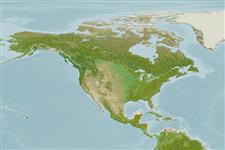>
Perciformes/Serranoidei (Groupers) >
Serranidae (Sea basses: groupers and fairy basslets)
Etymology: Hypoplectrus: Greek, hypo = under + Greek, plektron = sting, spur (Ref. 45335); ecosur: Named for the acronym of El Colegio de la Frontera Sur; noun in apposition..
Environment: milieu / climate zone / depth range / distribution range
Ecologia
marino associati a barriera corallina; distribuzione batimetrica 1 - 10 m. Tropical
Western Atlantic: Mexico (known only from off Contoy, at the northern tip of the Yucatan Peninsula); but may extend into the Gulf of Mexico and Cuba.
Size / Peso / Age
Maturity: Lm ? range ? - ? cm
Max length : 10.0 cm SL maschio/sesso non determinato; (Ref. 91468)
Short description
Morfologia | Morfometria
Spine dorsali (totale): 10; Raggi dorsali molli (totale): 14-15; Spine anali 3; Raggi anali molli: 7. This species has the usual color and patterns of the brown Barred Hamlet but with some distinguishing markings: a pair of dark rounded spots found at the base of the caudal fin, above and below the midline, usually symmetrical, present on all stages, including adults; a series of four dark brown to black spots at the upper rear body with one smaller rounded spot at the dorsal edge of the narrow mid-body bar (fourth bar), a larger oval blotch, vertically elongated at the anterior upper end of the fifth bar, a smaller flattened spot at the rear upper edge of the fifth bar below the base of the last dorsal-fin rays, and a narrow squared blotch on the upper caudal peduncle filling the space between two thin blue bars (not the full width of the sixth bar); characters not frequent on Caribbean Barred Hamlets, but associated with this species and H. floridae, include the bar under the eye being orange, even when the body bars are brown, plus a dusky pelvic fin (Ref. 91468).
Life cycle and mating behavior
Maturità | Riproduzione | Deposizione | Uova | Fecundity | Larve
Victor, B.C., 2012. Hypoplectrus floridae n. sp. and Hypoplectrus ecosur n. sp., two new Barred Hamlets from the Gulf of Mexico (Pisces: Serranidae): more than 3% different in COI mtDNA sequence from the Caribbean Hypoplectrus species flock. J. Ocean Sci. Found. 5:1-19. (Ref. 91468)
IUCN Red List Status (Ref. 130435)
Threat to humans
Harmless
Human uses
Informazioni ulteriori
Nomi ComuniSinonimiMetabolismoPredatoriEcotossicologiaRiproduzioneMaturitàDeposizioneSpawning aggregationFecundityUovaEgg development
Age/SizeAccrescimentoLength-weightLength-lengthLength-frequenciesMorfometriaMorfologiaLarveDinamica popolazioni larvaliReclutamentoAbbondanzaBRUVS
BibliografiaAcquacolturaProfilo di acquacolturaVarietàGeneticaElectrophoresesEreditarietàMalattieElaborazioneNutrientsMass conversion
CollaboratoriImmaginiStamps, Coins Misc.SuoniCiguateraVelocitàModalità di nuotoArea branchialeOtolithsCervelliVista
Strumenti
Special reports
Download XML
Fonti Internet
Estimates based on models
Phylogenetic diversity index (Ref.
82804): PD
50 = 0.5000 [Uniqueness, from 0.5 = low to 2.0 = high].
Bayesian length-weight: a=0.01778 (0.00680 - 0.04650), b=3.03 (2.80 - 3.26), in cm total length, based on LWR estimates for this (Sub)family-body shape (Ref.
93245).
Trophic level (Ref.
69278): 3.8 ±0.4 se; based on size and trophs of closest relatives
Fishing Vulnerability (Ref.
59153): Low vulnerability (10 of 100).
